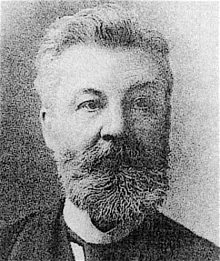
John Douglas [also known as "John Douglas of Chester"] was born was born in Sandiway, Cheshire, England on 11 April 1830 and was articled to Edward Graham Paley (1823-1895) of Sharpe & Paley in Leicester in the 1840s.
He commenced independent practice as an architect in c.1860 in Chester, Cheshire and worked on his own until 1884 when he formed a partnership with Daniel Porter Fordham (1845?-1899) in the Chester-based architectural practice Douglas & Fordham. They were in partnership until 1897 when Fordham retired from the he practice for health reasons. After working alone again, Douglas formed a partnership with Charles Howard Minshull (1858-1934) as Douglas & Minshull in Chester.
Failing health forced Douglas to retire in 1909 and Minshull took over the practice. In c.1911 he took on a new partner, Joseph Edward Muspratt (1857-1928). The firm subsequently continued as Douglas, Minshull & Muspratt. It retained this title until at least the mid-1920s.
Douglas died in Dee Banks, Chester, England on 23 May 1911.
Notable work by Douglas included a new wing for Vale Road Abbey in Whitegate, Cheshire (1860); St John's Church in Over, Cheshire (1860-63); Congregational Chapel in Over, Cheshire (1865); a shop at 19–21 Sankey Street, Warrington, Cheshire (1864); a lodge and other buildings at Grosvenor Park, Chester (1865–67); St John the Baptist's Church in Aldford, Cheshire (1865–66); Oakmere Hall, near Cuddington, Cheshire (1867); St Ann's in Warrington, Cheshire (1868–69); buildings on the Eaton Hall estate near Eccleston, Cheshire (1869- early 1890s); Shotwick Park near Saughall, Cheshire (1872); restoration of St John the Baptist's Church in Hartford, Cheshire (1873–75); restoration of Mary's Church in Whitegate, Cheshire (1874); rebuilding of St Paul's Church, Boughton in Chester, Cheshire (1876); The Geli in Tallarn Green, Flintshire (1877); St Michael and All Angels Church in Altcar, Cheshire (1878-79); 6–11 Grosvenor Park Road, a terrace of houses in Chester, Cheshire (c.1879-81); Eccleston Hill Lodge in Eccleston, Cheshire (1881); Eccleston Hill in Eccleston, Cheshire (1881–82); Grosvenor Club in Chester, Cheshire (1881-83); North and South Wales Bank in Chester, Cheshire (1881–83); St Mary's Church in Pulford, Cheshire (1881–84); Eccleston Paddocks in Eccleston, Cheshire (1882-83); Barrowmore Hall in Great Barrow, Cheshire (c.1883); a building for the Cheshire County Constabulary at 142 Foregate Street, Chester, Cheshire (1884); Abbeystead House in Abbeystead, Lancashire (with Fordham, 1885-87); Ford Lane Farm, near Aldford, Cheshire (1890); Obelisk, Belgrave Avenue, Eaton Hall estate, Chesire (1891); Church of St James the Great in Haydock, Cheshire (with Fordham, c.1891-92); St Wenefrede's Church in Bickley, Cheshire (with Forham, 1892); All Saints Church in Higher Kinnerton, Flintshire (with Fordham, 1893); Post Office, Warburton, Cheshire (1893); Brocksford Hall in Doveridge, Derbyshire (with Fordham, 1893); Eccleton Lodge and gates, Eaton Hall estate, Cheshire (1894); East side (including Martin's Bank) os St. Warburgh Street, Chester (1895-99); St. Oswald's Chambers, St. Warburgh Street, Chester (.1895); Walmoor Hill, Dee Banks, near Chester for himself (1896); 38 Bridge Street in Chester, Cheshire (with Fordham, 1897); Dee Banks, in Chester, Cheshire, his own house (1897); Congregational Church in Great Crosby, Lancashire (with Fordham, 1897–98); Diamond Jubilee Clock, East Gate, Chester (1897-99); St John the Evangelist's Church in Weston, Runcorn, Cheshire (1897–1900); St Oswald's Chambers in St Werburgh Street, Chester (with Minshull, 1898); Congregational Church, Eshe Road North, Great Crosby, Lancashire (1898); Public Baths, Chester (with Minshull, 1898-1901); St Ethelwold's Church, Shotton, Flintshire (with Minshull, 1898–1902); additions to St Matthew's Church Buckley, Flintshire (with Minshull, 1898-1905); St Deiniol's Library, Hawarden, Flintshire (with Minshull, 1899-1906); St. Paul's Church, Broughton, Cheshire (1902); St John the Evangelist's Church in Sandiway, Cuddington, Cheshire (with Minshull, 1902-03); and Episcopal Church, Lockerbie, Dumfriesshire (with Minshull, 1903).
____
See also
Avery, Derek. Victorian and Edwardian Architecture. London: Chaucer Press, 2003
Armstrong, Barrie and Armstrong, Wendy. The Arts and Crafts movement in the North West of England: a handbook. Wetherby, England: Oblong Creative Ltd., 2006
Button, Roger. Arts and Crafts Churches of Great Britain: Architects, Craftsmen and Patrons.. Settle, North Yorkshire: 2QT Ltd. (Publishing) Ltd., 2020
Directory of British Architects 1834-1914. Compiled by Antonia Brodie, et al. Volume 1: A-K. London; New York: British Architectural Library, Royal Institute of British Architects/Continuum, 2001
Girouard, Mark. The Victorian Country House. New Haven and London: Yale University Press, revised and enlarged edition, 1979
Gray, A. Stuart. Edwardian architecture: a biographical dictionary. London: Gerald Duckworth & Co., Ltd., 1985
Hamilton, Alec. Arts & Crafts Churches. London: Lund Humphries, 2020
Hubbard, Edward. The Work of John Douglas. London: The Victorian Society, 1991
King, Roger. John Douglas, 1830-1911: a brief account by Roger King of Cheshire's outstanding architect. Northwich, England: Northwich & District Heritage Society, 2005
‘Obituary’. The Builder vol. 100, 2 June 1911 p. 697
‘Obituary’. RIBA Journal vol. 18, 1911 pp. 589-590
Stamp, Gavin. The English House 1860-1914. Catalogue of an exhibition of photographs and drawings. London: InternationalArchitect and the Building Centre Trust, 1980 pp. 21-22